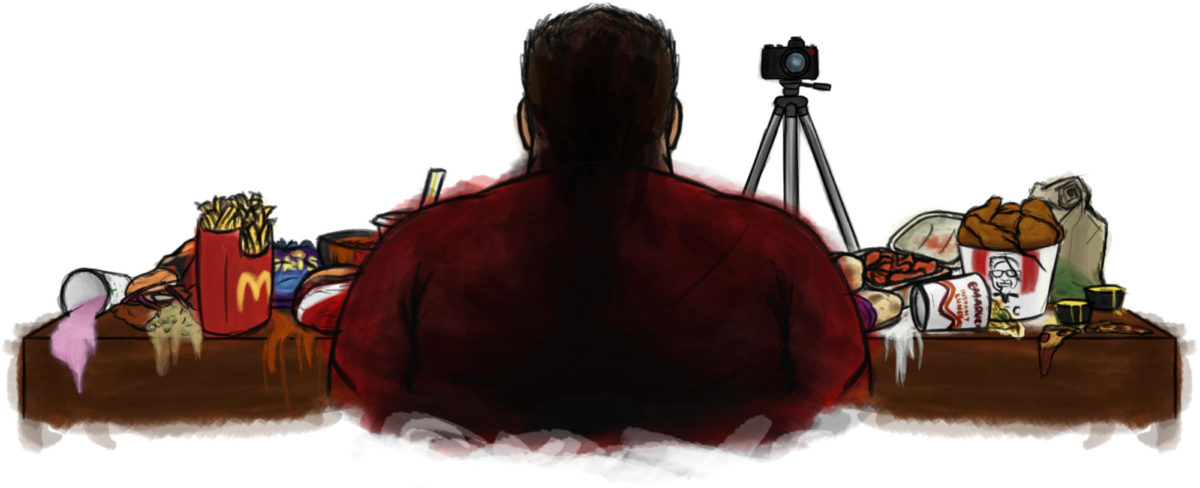The abridged version of this article appeared in the June 2023 print edition of The Mirror. This is an uncut version.
On social media, people constantly strive to go viral. Some will do anything to achieve that goal, even if it means filming themselves eating two large trays of McDonald’s burgers and fries for an hour straight.
A popular topic for content creation is mukbangs. Originating in South Korea, mukbangs have become a lasting trend on social media platforms due to the comforting feeling they provide for audiences, akin to sharing a meal with a friend. The term was coined by combining two Korean words: “muk-ja” (먹자), meaning “to eat,” and “bang song” (방송), meaning “broadcast.” Mukbangs can be described as intimate cooking shows that focus on the eating aspect rather than the cooking process. They rose to popularity in South Korea during the 2010s and gradually gained traction in the United States in subsequent years.
Since mukbangs became such a popular subject, the total number watched from October 2017 to April 2018 grew up to 176 million more views.That is more than a 12% increase in a year. Many times they collaborate with channels completely different to their genre, such as beauty creators, to reach a larger diversity to their audience.
Mukbangs have become so popular that some people have built entire YouTube channels around them, dubbing themselves mukbangers. Initially, the creators of these videos had innocent intentions: to provide comfort to others during times of loneliness. However, nowadays, many creators prioritize landing on the trending page with eye-catching thumbnails, messy eating and oversized, unhealthy food portions.
Although mukbangs might seem like harmless entertainment, just like other content on YouTube, the negative impacts they create for people and the environment far outweigh their benefits. One such negative effect is food wastage.
Creators such as Nikocado Avocado and Eat With Boki faced heavy criticism when viewers discovered they edited their videos to remove segments where they spit out chewed food. Mukbangers frequently pile heaps of food on their plates to captivate viewers. Once they finish filming, they discard their leftovers, thereby setting a detrimental precedent concerning food shortages and waste issues currently affecting other countries.
While some mukbang creators claim they donate leftovers to struggling communities, the quality of the food being donated isn’t what hungry people can realistically use. Much of what Mukbang creators consume comprises processed foods full of saturated fats, such as McDonald’s, Taco Bell and In-N-Out. These creators should reduce their food consumption rather than merely eat large portions and give away the leftovers.
Exposure to mukbang YouTubers may encourage viewers to adopt binge eating behaviors. Mukbangs often depict people consuming vast amounts of food, far exceeding what is considered a balanced meal. They present overeating as entertainment and overlook appropriate portion sizes for a healthy diet.
The growing popularity of mukbangs comes with a downside, as creators gain attention and fame by eating excessive amounts of food on camera. Young audiences are impressionable, and mukbangers have become idolized for their eating habits, potentially contributing to eating disorders.
For example, Nikocado Avocado, also known as Nicholas Perry, is a prominent mukbang creator who has faced criticism for his use of the platform to gain views. Perry began as a mukbanger in 2016, initially following a vegan lifestyle. However, he later abandoned veganism and started creating extreme mukbangs featuring large trays of fast food, spicy instant noodles and other processed foods.
As Perry’s weight increased, his videos took a disturbing turn. He would film himself eating while crying into his food, discussing his crumbling life and body dissatisfaction. The more unsettling his thumbnails and videos appeared, the higher his view count climbed. Hundreds of YouTube compilation videos showcased Perry’s ongoing meltdowns and the copious amounts of fast food he devoured on camera. He quickly became one of the most infamous mukbang YouTubers, causing the genre to be associated with people like him.
Naturally, Perry wasn’t the sole mukbang creator known for excessive consumption of unhealthy food. Other popular mukbangers on YouTube include Zach Choi and Trisha Paytas. Although not as controversial as Perry, their videos still impact younger audiences by promoting unhealthy eating habits.
Taking a more conscientious approach, some mukbang creators use their platform to promote healthy eating habits and demonstrate how food can be mindfully enjoyed in moderation. Stephi Nguyen, one of these health-focused creators, has amassed a substantial following on YouTube with her plant-based mukbangs centered around wholesome foods. By showcasing her nutritious meals and inspiring viewers to make positive dietary changes, she counters the detrimental influence that many other mukbang creators have perpetuated.
Though mukbangs offer entertainment value, we must not overlook the problems of binge eating and consider the consequences. It’s vital to educate the public, particularly influencers with large followings, about the impact of such practices. Social media users share a responsibility in promoting healthy food habits instead of endorsing unhealthy ones.



